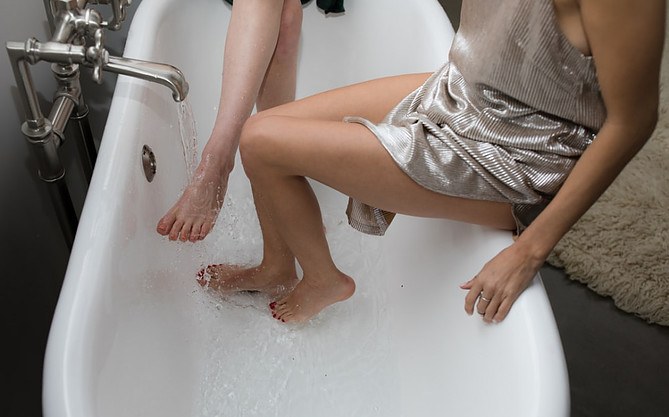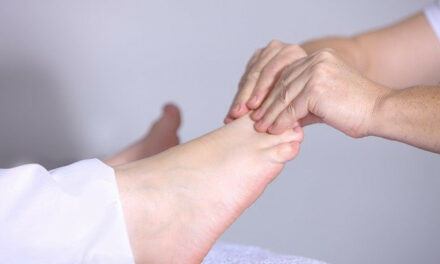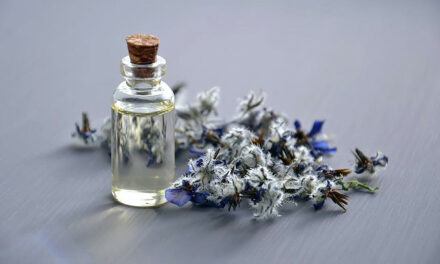For centuries, Epsom salt has been used as a pain reliever and a healing agent. In recent times it is usually added to foot soaks and baths to reduce stress and help relaxation. Aside from being a natural remedy for minor aches when dissolved in warm water, Epsom salt can also help treat fungal infection, wart, gout and eliminate odours. But, does Epsom salt kill toenail fungus and warts? That’s what we are about to find out in this article.
Toenail fungus and warts are, in most cases, considered cosmetic problems. After a while, they often go away (if you maintain good hygiene) on their own without treatment. But they can be embarrassing and unpleasant to look at, which is why many people look for easy home remedies to treat them.
Let’s find out more about Epsom salt now… what is it?
What is Epsom Salt?
Epsom salt, otherwise known as magnesium sulphate and bath salt, is a chemical compound composed of magnesium, sulphur and oxygen. It got the name Epsom from Epsom town in Surrey, England, where it was first discovered.
Contrary to its name, Epsom salt is quite different from regular table salt. It doesn’t have the same compound as table salt, but due to its chemical structure, it has been termed “salt”.
It may look like table salt, but it has a bitter and unpalatable taste, much like Dead Sea salt but not the same. Epsom salt can be consumed by dissolving in water then drinking it. But because it doesn’t taste good, you might not want to add it to your dish.
How Does Epsom Salt Work?
As Epsom salt is dissolved in water, it releases sulphate ions and magnesium. They are then absorbed into the body through the skin. Most benefits associated with Epsom salt has to do with Magnesium
or sulphates.
The magnesium in Epsom salt is quickly absorbed via the skin, and that takes only a few minutes. However, and there is no scientific evidence to prove that magnesium levels in the body (blood) has increased by absorbing it through the skin. Nevertheless, Epsom salt is widely used as a bath salt and foot soak most of the time, with accompanying personal benefits.
Uses of Epsom Salt
Epsom salt can be taken orally or used in baths or soaks, depending on the intended use.
- Orally
Unadulterated Epsom salt, free of additives and fragrance can be taken orally, mainly as a laxative.
It is not to be taken without prescription from a doctor, especially for pregnant persons, people with kidney disease, stomach pain, vomiting and nausea, and for those on magnesium restricted diet.
- Baths and soaks
You can soak the achy area in Epsom saltwater solution. It relieves tired or swollen ankles and feet according to popular belief.
Anecdotal evidence suggests that it reliefs sore muscles and itchiness caused by mosquito bites or poison ivy. There are also reported cases of people with psoriasis who use it to soften their skin.
Tip: Did you know that Epsom salt bath can lower high blood pressure?
What is Toenail Fungus?
This is a rather common condition that starts as a yellow or white spot beneath the tip of your toenail or fingernail. As it worsens, it can spread and affect other nails, making them discolored and thickened, then they begin to crumble at the edge.
When the fungus infects the area between the skin of your feet and your toes, it is called athlete’s foot.
Fungi, just like bacteria, are normally present on and in the body. An overgrowth of fungi on, in or under the nail, causes a fungal nail infection. You may also contract it by coming in contact with anyone who has a fungal infection, or tools used by someone who has it (such as unsanitized nail clippers).
Some people are more likely and prone to develop fungal nail infection. They are most like individuals with the following medical conditions.
- with a disease that resulted in poor blood circulation
- have diabetes (Here we explain how Chinen salt can help diabetics)
- wear artificial nails
- are over the age of 65
- swim in public pools
- have weak immune systems
- have nail injury
- wear closed-toe shoes such as boots
- have moist toes and fingers for a long period of time
- have a skin injury around the nails
- are male adults
Symptoms of Toenail Fungus
If your nails have one or more of these symptoms, then you may have nail fungus.
- Whitish to yellow-brown nail discoloration
- Distorted nail shape
- Thickened nails
- Brittle, crumbly or ragged nails
- Slightly foul-smelling nails
- Dark colored nails caused by debris build-up under the nail
Common Types of Nail Fungus
- Distal subungual infection
This infection is the most common type, and it develops both in the toenails and fingernails.
In this case, the outer edge of the nail appears jagged with yellow and/or white streaks across it. The infection grows into the underside of the nail and nail bed.
- Candida infection
This type of infection is caused by candida yeasts. It usually affects fingernails and often in individuals who soak their hands in water most of the time. It starts infecting the cuticle around the nail and makes it red, swollen and tender to touch. As it progresses, the nail may become partially lifted off the nail bed, or completely fall off.
- White superficial infection
This is a type of fungal attack that affects the surface layers of the nail (usually toenails), and creates distinct white spots on the nail. Progressively, these white spots cover the whole nail, which becomes rough and starts crumbling. The spots may become flaky and pitted.
- Proximal subungual infection
This type is uncommon and can affect both the toenails and fingernails. As the infection spreads upward, yellow spots likely to appear at the base of the nail.
Now, let’s look explore about warts.
What is a Wart?
Warts are small growths that appear anywhere on the body. The skin infection can look like a small cauliflower or a solid blister with a rough texture.
Warts are caused by strains of HPV (Human Papillomavirus), and they are contagious. Touching someone who has them is enough to infect you.
Most warts clear up on their own without treatment. It may take a few weeks or a few years, depending on the number of warts and the location.
As many as 1 in every 3 teenagers and children are estimated to have warts, with only about 3% to 5% of adults. This is mostly because adults have a stronger immune system that better prevents the development of warts over time. That also means, adults with weak immune systems are more likely to have warts.
How a wart looks like depends on the location and the thickness of the skin. They usually appear on the hands, feet, face, and uncommonly on the genitals and knees.
Types of Wart
Each type of wart has a unique appearance and appear in different parts of the body.
- Common wart (Hands)
Common warts grow on the toes and fingers. They have a rounded top and a rough, grainy appearance. They appear greyer than the surrounding skin and can also appear elsewhere apart from the toes and fingers.
- Flat wart (Face)
Flat warts form on the face, arms or thighs. They can be brownish, pink or slightly yellow.
Flat warts are small, hardly noticeable and have flat tops.
- Planter wart (Feet)
This type of wart grows on the soles of the feet, and they grow into your skin, unlike other warts.
If you have planter wart, you will notice what appear to be a little hole under your foot, surrounded by hardened skin. They can really make walking uncomfortable.
- Periungual and Subungual wart (Nails)
They grow around and under the fingernails and toenails. These warts affect nail growth and are usually painful.
- Filiform wart
They usually grow around the nose or mouth and oftentimes under the chin and on the neck. Filiform warts have the same colour as the skin. They are little and shaped like a tag of skin.
Tip: CBD oil can help remove warts.
How Does Epsom Salt Kill Toenail Fungus?
Epsom salt has been used to treat infections and wounds for a very long time. It can draw out the fungal infection but doesn’t cure it, according to the Epsom Salt Council. But, by softening the skin, it accelerates the effect of the medication prescribed by your physician.
Even though it is used to treat infections, it can also cause irritation to the wound; so, make sure you consult with your doctor before using this remedy.
Remember, most of the time, nail fungus comes back even if treatment is successful.
How Does Epsom Salt Kill Warts?
There is barely any research that supports the use of Epsom salt to kill the wart virus, contrary to the popular belief that it does. While it works for some, several others experience no improvement after using Epsom salt in an attempt to kill warts.
The use of Epsom salt in hand and foot soaks over a period of time seems to dry out warts, and they eventually disappear. Epsom salt makes the warm water acidic, and this may be why warts disappear over time, but it is yet to be proven.
An important thing to know is that, even after warts disappear, they may reappear again and again over the period of 1 to 2 years. Repeat the Epsom salt warm water soak again, if it does help, until warts permanently disappear.
Other Benefits of Epsom Salt Foot Soaks
- Magnesium
Absorbing Epsom salt through foot soaks provides the body with enough magnesium, which plays a major role in bodily function.
- Sleep promotion and Stress reduction
Epsom salt is known to reduce stress and fatigue. Magnesium helps the body produce melatonin hormones which promotes sleep. It also helps the brain to produce neurotransmitters that reduce stress and induce sleep.
- Pain relief
Magnesium is a soothing agent present in Epsom salt, which helps with relaxation and pain relief. Many people suffering from arthritis and fibromyalgia have reported improvement in their symptoms after taking Epsom salt baths.
- Improved exercise performance and recovery
Epsom salt foot soaks can relieve cramps and reduce muscle soreness.
Tips for Soaking With Epsom Salt To Kill Toenail Fungus and Warts
To make a simple Epsom salt foot soak at home, follow these steps:
- Have a basin or bathtub
ready and filled with warm water, deep enough to cover your feet. - Add about 1/2 to 1/3 cup of Epsom salt
- Consider adding a few drops of tea tree oil (an essential oil with antiseptic and antifungal abilities), peppermint, eucalyptus essential oil or diluted lavender to your foot bath, for aromatherapy and healing support.
- Soak your feet between 30 to 60 minutes, a couple of times a week.
- Gently exfoliate your skin, after it has been softened from the soak.
- Using a Pumice stone or Emory board, gently scrub away any remnant of warts. Ensure you get rid of any tool you may have used to scrub the wart to avoid spreading the virus within the family.
- Remember to thoroughly moisturize your feet after soaking them. This is to avoid cracked skin and irritation because Epsom salt foot soak can cause dry skin.
Cautions!
Epsom salt is a natural remedy that is affordable and comes with minimal risk. But some precautions still have to be taken to avoid complications, depending on your health condition.
- Go for Epsom salt that is USP
designated, which means it has met safety regulations established by the FDA. Epsom salt recommended for foot soak can be found in pharmacies, online, or at health food stores. - If you already have dry skin, it might be best to avoid overdoing foot soaks. Epsom salt can dry out the skin and leave your feet more vulnerable to cracks. Moisturize your skin thoroughly after a foot soak.
When to Pay a Visit To Your Doctor?
You must visit your doctor or a podiatrist if you notice any of the below.
- If you start experiencing pain, sores or redness before or after using a foot soak, fix an appointment with your treating doctor to discuss other treatment alternatives.
- When the nail is increasingly discolored, deformed or thickened from fungal nail infection, you may want to see a physician if home remedies aren’t helping.
- If you’re developing fungal nail infection and you have diabetes or a weakened immune system, you have to see your doctor first.
- In the case of genital warts, it is a serious condition and requires the assessment of a doctor.
Who Shouldn’t Have an Epsom Salt Foot Soak?
- Diabetics need to consult with their doctor before considering Epsom foot soak or any other foot soak for that matter.
Diabetes individuals often have nerve damage from diabetic neuropathy, and dry feet, and their wounds
generally take a long time to heal. So, using Epsom foot soak may result in complications or worsen their condition.
- If there are open sores, wounds, or severe skin infection and inflammation on your feet, do not use an Epsom salt foot soak without first consulting with your physician. Some common skin infections can be worsened from using it.
Other Alternative Foot Soaks To Cure Toenail Fungus and Warts
- Vinegar foot soak
Vinegar has antimicrobial properties which help to improve conditions such as warts, athlete’s foot, nail fungus and foot odor.
White or Cider vinegar
are most suitable for foot soaks because they contain a higher percentage of acetic acid. Use 1 part vinegar and 2 part warm water for a foot soak.
You could use apple cider vinegar too as described below.
Tip: See how essential oils can help corns and bunions.
- Listerine foot soak
The ‘Listerine’ you know, a branded mouthwash, can be used to cure foot problems such as fungal infections, smelly feet and wart.
It can be added to warm water and used as a foot soak, or applied directly to the wart, and works like magic. After a couple of weeks or more, the results begin to show.
Other alternative combinations include – Listerine and vinegar foot soak, Vinegar and baking soda foot soak, Listerine and Dawn foot soak.
Conclusion
Epsom salt foot soak can be a natural, affordable and safe complementary alternative to medicine, for foot ailments. While there have been several success stories surrounding the use of Epsom salt as a healing agent, adequate research is still needed to understand its effectiveness.
Nevertheless, before using Epsom salt to treat nail fungal infection or wart, schedule an appointment with your doctor to discuss possible treatment options.
Lastly, individuals that are diabetic, pregnant, with heart problems or kidney disease, should consult with their physician before using Epsom salt.











